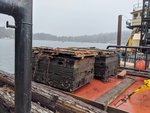Using a barge-mounted crane, U.S. Army Corps of Engineers crews have pulled vestiges of a World War II torpedo defense system out of Mats Mats Bay, where the parts had washed in and become a navigational hazard.
This item is available in full to subscribers.
We have recently launched a new and improved website. To continue reading, you will need to either log into your subscriber account, or purchase a new subscription.
If you had an active account on our previous website, then you have an account here. Simply reset your password to regain access to your account.
If you did not have an account on our previous website, but are a current print subscriber, click here to set up your website account.
Otherwise, click here to view your options for subscribing.
* Having trouble? Call our circulation department at 360-385-2900, or email our support.
Please log in to continue |
|

Using a barge-mounted crane, U.S. Army Corps of Engineers crews have pulled vestiges of a World War II torpedo defense system out of Mats Mats Bay, where the parts had washed in and become a navigational hazard.
“We successfully pulled four 12,000 lb. creosote wood floats that had become trapped in Mats Mats Bay,” said Bradford Schultz, who is chief of the Corps of Engineers’ Waterway Maintenance Unit. The process took two days.
Called “baulks” the massive boxes were armed with spikes and had originally been loose-rigged on cables, floating in Navy harbors where ships are easy targets for torpedo attacks. The baulk system was designed to wrap around and sink speedy attack boats Axis navies used to slip into shipyards or moorages to launch torpedoes.
A 1944 Navy manual on net and boom defenses described how shallow-draft wood-hulled torpedo boats successfully attacked even ships moored behind steel submarine nets and minefields, “relying upon darkness and their speed to elude defensive gunfire.”
The heavy iron-strapped wood and metal box enclosed two watertight iron tanks to float it. The Navy designed the baulk system of cables to cause the baulks to swing hard against a speed boat, caving in the hull and sinking it before it could launch torpedos.
Puget Sound was a ship-building powerhouse in the late 1930s and 1940s. Tacoma, Seattle, Bremerton and other cities cranked out freighters, transports, escort carriers, destroyers, minesweepers and other craft, which meant the area was a likely target for enemy attack.
Schultz said the tangle of material took two days two clean up.
“We also removed around 10 creosote logs. The large floats took extensive rigging and cutting over the course of two days so we could work on them at low and high tides.”
Schultz is part of the Corps of Engineers’ team that operates the M/V Puget, a debris recovery vessel that removes navigational obstacles from waterways, as well as derelict objects that may threaten public health or the environment.
Schultz called the project a success. “Pretty neat mission and a new corner of Puget Sound explored for those involved,” Schultz said.